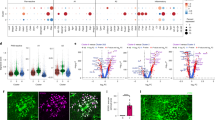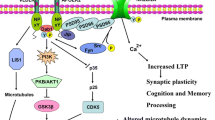Abstract
Leucine-rich glioma inactivated (LGI) 3 encodes a leucine-rich repeat protein. The precise function of LGI3, however, remains unknown. We have previously shown that amyloid-β peptide (Aβ) upregulates LGI3 and that Aβ and LGI3 colocalize on plasma membranes of cultured rat astrocytes. In the present study, we performed immunohistochemical and biochemical analyses of LGI3 using various aged monkey brains. Immunohistochemistry showed that LGI3 was present in almost all neural cells and mainly localized at plasma membranes and nuclei. In aged monkey brains, we found that LGI3 accumulated on or near the plasma membranes of neurons, and colocalized with endocytosis-associated proteins and lipid raft markers. Double immunohistochemistry also showed that LGI3 colocalized with Aβ in astrocytes of aged brains. Moreover, Western blot analyses revealed that LGI3 may be cleaved in brain. Additionally, in aged monkeys LGI3 accumulated in microsomal and nuclear brain fractions.





Similar content being viewed by others
References
Bahr BA, Bendiske J (2002) The neuropathogenic contributions of lysosomal dysfunction. J Neurochem 83(3):481–489
Bendiske J, Bahr BA (2003) Lysosomal activation is a compensatory response against protein accumulation and associated synaptopathogenesis—an approach for slowing Alzheimer disease? J Neuropathol Exp Neurol 62(5):451–463
Buchanan SG, Gay NJ (1996) Structural and functional diversity in the leucine-rich repeat family of proteins. Prog Biophys Mol Biol 65:1–44
Cataldo AM, Peterhoff CM, Troncoso JC, Gomez-Isla T, Hyman BT, Nixon RA (2000) Endocytic pathway abnormalities precede amyloid beta deposition in sporadic Alzheimer’s disease and Down syndrome: differential effects of APOE genotype and presenilin mutations. Am J Pathol 157(1):277–286
Chen F, Gu Y, Hasegawa H, Ruan X, Arakawa S, Fraser P, Westaway D, Mount H, St. George-Hyslop P (2002) Presenilin 1 mutations activate Aβ42 secretase but reciprocally inhibit ε-secretase cleavage of APP and S3-cleavage of Notch. J Biol Chem 277:36521–36526
Ebino JO, Yankner BA (2002) A RIPtide in neuronal signal transduction. Neuron 34:499–502
Fukamachi K, Matsuoka Y, Ohno H, Hamaguchi T, Tsuda H (2002) Neuronal leucine-rich repeat protein-3 amplifies MAPK activation by epidermal growth factor through a carboxyl-terminal region containing endocytosis motifs. J Biol Chem 277(46):43549–43552
Glenner GG (1988a) Alzheimer’s disease: its proteins and genes. Cell 52(3):307–308
Glenner GG (1988b) The proteins and genes of Alzheimer’s disease. Biomed Pharmacother 42(9):579–854
Greenwald I (1998) LIN-12/Notch signaling: lessons from worms and flies. Genes Dev 12(12):1751–1762
Gu W, Wevers A, Hannsjorg S, Grzeschik KH, Derst C, Brodtkorb E, De Vos R, Steinlein OK (2002) The LGI1 gene involved in lateral temporal lobe epilepsy belongs to a new subfamily of leucine-rich repeat proteins. FEBS Lett 519:71–76
Ikonen E (2001) Roles of lipid rafts in membrane transport. Curr Opin Cell Biol 13(4):470–477 Review
Kimura N, Nakamura S, Honda T, Takashima A, Nakayama H, Ono F, Sakakibara I, Doi K, Kawamura S, Yoshikawa Y (2001) Age-related changes in the localization of presenilin-1 in cynomolgus monkey brain. Brain Res 922:30–41
Kimura N, Tanemura K, Nakamura S, Takashima A, Ono F, Sakakibara I, Ishii Y, Kyuwa S, Yoshikawa Y (2003) Age-related changes of Alzheimer’s disease-associated proteins in cynomolgus monkey brains. Biochem Biophys Res Comm 310:303–311
Kimura N, Yanagisawa K, Terao K, Ono F, Sakakibara I, Ishii Y, Kyuwa S, Yoshikawa Y (2005) Age-related changes of intracellular Aβ in cynomolgus monkey brains. Neuropathol Appl Neurobiol 1(2):170–180
Kimura N, Ishii Y, Suzaki S, Negishi T, Kyuwa S, Yoshikawa Y (2007) Aβ upregulates and colocalizes with LGI3 in rat cultured astrocytes. Cell Mol Neurobiol 273:335–350
Kobe B, Deisenfofer J (1994) The leucine-rich repeat: a versatile binding motif. Trends Biochem Sci 19:415–421
Mattson MP (2004) Pathways towards and away from Alzheimer’s disease. Nature 430(7000):631–639
Molander-Melin M, Blennow K, Bogdanovic N, Dellheden B, Mansson JE, Fredman P (2005) Structural membrane alterations in Alzheimer brains found to be associated with regional disease development; increased density of gangliosides GM1 and GM2 and loss of cholesterol in detergent-resistant membrane domains. J Neurochem 92(1):171–182
Mousavi SA, Malerod L, Berg T, Kjeken R (2004) Clathrin-dependent endocytosis. Biochem J 377(Pt 1):1–16 Review
Nakamura S, Nakayama H, Goto N, Sakakibara I, Yosikawa Y (1998) Histopathological studies of senile plaques and cerebral amyloidosis in cynomolgus monkeys. J Med Primatol 27(5):244–252
Nixon RA (2005) Endosome function and dysfunction in Alzheimer’s disease and other neurodegenerative diseases. Neurobiol Aging 26(3):373–382
Pasternak SH, Callahan JW, Mahuran DJ (2004) The role of the endosomal/lysosomal system in amyloid-beta production and the pathophysiology of Alzheimer’s disease: reexamining the spatial paradox from a lysosomal perspective. J Alzheimers Dis 6(1):53–65
Sastre M, Steiner H, Fuchs K, Cappell A, Multhaup G, Condron MM, Teplow DB, Haass C (2001) Presenilin-dependent γ-secretase processing of β-amyloid precursor protein at a site corresponding to the S3 cleavage of Notch. EMBO Rep 2:835–841
Satoh K, Hata M, Yokota H (2002) A novel member of the leucine-rich repeat superfamily induced in rat astrocytes by beta-amyloid. Biochem Biophys Res Commun 290(2):756–762
Scheel H, Tomiuk S, Hofmann K (2002) A common protein interaction domain links two recently identified epilepsy genes. Hum Mol Genet 11(15):1757–1762
Schulte U, Thumfart JO, Klocker N, Sailer CA, Bildl W, Biniossek M, Dehn D, Deller T, Eble S, Abbass K, Wangler T, Knaus HG, Fakler B (2006) The Epilepsy-linked LGI1 protein assembles into presynaptic KV1 cannels and inhibits inactivation by KVβ1. Neuron 49(5):697–706
Senechal KR, Thaaller C, Noebels JL (2005) ADPEAF mutations reduce levels of secreted LGI1, a putative tumor suppressor protein linked to epilepsy. Human Mol Genet 14(12):1613–1620
Tamai Y, Kojima H, Ohtani Y, Uchida K, Taguchi F, Kawaguchi T, Miura S, Tateishi J (1989) Subcellular distribution of the transmissible agent in Creutzfeldt-Jakob disease mouse brain. Microbiol Immunol 33(1):35–42
Vance JE, Campenot RB, Vance DE (2000) The synthesis and transport of lipids for axonal growth and nerve regeneration. Biochim Biophys Acta 1486(1):84–96 Review
Weidemann A, Eggert S, Reinhard FBM, Vogel M, Paliga K, Bailer G, Masters CL, Beyreuther K, Evin G (2002) A novel ε-cleavage within the transmembrane domain of the Alzheimer amyloid precursor protein demonstrates homology with Notch processing. Biochemistry 41:2825–2835
Younkin SG (1994) The amyloid beta protein precursor mutations linked to familial Alzheimer’s disease alter processing in a way that fosters amyloid deposition. Tohoku J Exp Med 174:217–223
Yu C, Kim S-H, Ikeuchi T, Xu H, Gasparini L, Wang R, Sisodia SS (2001) Characterization of a presenilin-mediated amyloid precursor carboxyl-terminal fragment γ. J Biol Chem 276:43756–43760
Acknowledgment
This study was supported by a grant-in-aid for Young Scientists (B) from the Ministry of Education, Culture, Sports, Science and Technology, Japan (18790288).
Author information
Authors and Affiliations
Corresponding author
Rights and permissions
About this article
Cite this article
Okabayashi, S., Kimura, N. Immunohistochemical and Biochemical Analyses of LGI3 in Monkey Brain: LGI3 Accumulates in Aged Monkey Brains. Cell Mol Neurobiol 27, 819–830 (2007). https://doi.org/10.1007/s10571-007-9205-6
Received:
Accepted:
Published:
Issue Date:
DOI: https://doi.org/10.1007/s10571-007-9205-6




